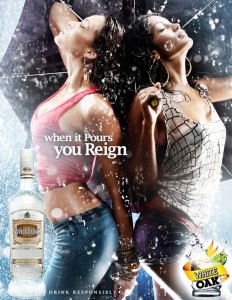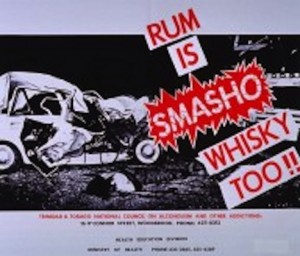Colour conscious
Posted: July 20th, 2010 | Author: lise | Filed under: Editorial | Tags: advertising, fashion, Race, society | 3 Comments » One of Miss Thing’s friends is a willowy beauty. She’s caramel coloured, with exotically slanting eyes and neat features. She’s a natural model, if I ever saw one. It’s not that she’s prettier than any other girl, but she seems to have that fortunate coincidence of height, slender build, perfect skin and good deportment that makes a good runway or photo model.
One of Miss Thing’s friends is a willowy beauty. She’s caramel coloured, with exotically slanting eyes and neat features. She’s a natural model, if I ever saw one. It’s not that she’s prettier than any other girl, but she seems to have that fortunate coincidence of height, slender build, perfect skin and good deportment that makes a good runway or photo model.
She went to a casting call the other day and came away feeling like, for the first time since she started this nascent career, she might not have nailed the job. Why? She wasn’t dark enough.
Yup. The casting call asked for a model who was “dark”. My girl went anyway and her caramel colour was too light for what they were looking for.
This particular call drew the annoyance of at least one person, who wrote in response to the call on FB: “Perhaps you didn’t realize publicizing skin preference in a model search … would register as discrimination…it does. And now you know. It’s not like you’re casting an actress to portray Rita Marley or Heather Headley…naturally she would need to fit unique and narrow aesthetic parameters. Caribbean Beauty in 2010 is defined by a melange of aesthetics, not just ‘dark’ complexions.”
I thought about the post, the comment and my own outrage (particularly on behalf of my daughter’s friend) that the call was so restrictive. But was it racist? That’s another question. In 2010 are we doing the opposite of what our grandparents did 50 years ago? Are we turning the “brown paper bag” code on its head with reverse discrimination? Is it now, “Black, step up, brown, get down”?
I subscribe to a Yahoo group called TT Arts, which is used as a message board of sorts for all kinds of things. Publicising shows, advertising services, and yes, even casting calls. It was my friend Aaron’s misfortune to post a casting call for models for a commercial with the following requirements:
LIST OF MODELS NEEDED
GENDER COMPLEXION AGE
1) FEMALE BROWN approximetely 8 – 10
2) FEMALE BROWN 30
3) MALE BLACK 55
4) FEMALE BROWN 50
5) MALE INDIAN 30s
6) MALE BROWN 30s
7) FEMALE BLACK 25
8) MALE INDIAN 45
9) MALE BROWN 30s
10) FEMALE LIGHT BROWN 28
11) MALE CHINESE 30
12) MALE LIGHT BROWN 40
13) MALE BLACK 36 )
14) FEMALE BROWN 35 )
15) MALE BROWN 15 ) ALL ONE FAMILY
16) FEMALE BROWN 13 )
17) FEMALE BROWN 10 )
18) FEMALE LIGHT BROWN 35
19) MALE BROWN 50s
20) FEMALE BROWN 30s
I first wondered what the ad was for, because that is a huge cast. I next considered how far we’ve come in just 20 years; back when my ex- worked in advertising in T&T, the complexion he called “Cannings Brown” (a light, honey colour, not quite “red” but not as dark as sapodilla) was de rigueur in locally produced advertisements, whatever the product being advertised. Seeing actual dark skinned black people, not to mention dark skinned Indians, on TV in local ads was pretty rare.
I dismissed the casting call (I wasn’t interested in applying), but many others didn’t. A sudden and angry wave of emails followed:
“The true issue is that the terms such as ‘darkie’ have been used in the States and abroad to insult people with darker skin. Let us not forget the slave trade as well. People of all colours must be aware of the history of darker skinned people and understand why casting in such a light is frightening and disturbing to not only them but others who are aware of the racial ills in this world. Therefore, I suggest that next time you are casting do not make a list of different races. Simply state that you are a looking for various races to fill roles, ranging from men to women, young to old etc.”
“thanks man, every time i think i’m in the 21st century, you people are here to remind me the Caribbean is as racist as ever…what could you possibly need all those ‘brown’ ppl for…oh lemme guess, its a high class/colour commodity?”
“Only 1 ‘black’ female required for an advertisement in which several ‘brown’ or ‘light brown’ females are (with a similar ratio applying for the men). We are still heavily mired in an unhealthy colonial legacy.”
There was one voice in poor Aaron’s defense:
“If art imitates society then there has to be room for selective casting when aiming to depict life with true accuracy.
“Where is the line drawn between indiscriminate casting and casting for an accurate depiction of our society without being criticized for stereotyping and/or for contributing to racial divides?”
I don’t know if Aaron got his models. I can say for sure he got at least one response (from an actual model) from the call on TT Arts, from someone who wrote:
“I am available as a female brown 28/35. What’s your phone no?”
I wrote a manuscript some years ago and gave it around for some friends to read. One responded that one striking thing about it was how everyone’s colour was painstakingly described. He got tired of it, he said. I hadn’t before really considered how much I think about skin colour in my characters. But I didn’t change it, and continue to write characters’ descriptions that include their skin colours. I’m not colour blind, and I don’t want to be. The rich and various colours of our people are one of the things I like about this place. We are not homogenous.
Back to the model casting call. Were they right to call for a “dark” girl? Who defined “dark”? If they were white, my daughter’s friend would be considered pretty dark—but they’re not. They’re black, just like me, just like her. I wonder what will happen in the end with all of us colour conscious folk—conscious of colour but not necessarily restricted by it—when all the world is one uniform colour as Wayne Browne predicted?

